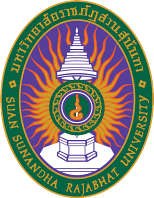การยอมรับเทคโนโลยีที่มีผลต่อความตั้งใจใช้ต่อเนื่องและแนะนำต่อของผู้ใช้แอพพลิเคชั่นสั่งอาหารในประเทศไทย
คำสำคัญ:
การยอมรับเทคโนโลยี, ความตั้งใจต่อเนื่อง, ความตั้งใจแนะนำต่อ, แอพพลิเคชั่นสั่งอาหารบทคัดย่อ
การศึกษาครั้งนี้มีวัตถุประสงค์เพื่อศึกษาปัจจัยด้านการยอมรับเทคโนโลยีที่มีผลต่อความตั้งใจใช้ต่อเนื่องและการแนะนำต่อของผู้ใช้แอพพลิเคชั่นสั่งอาหารในประเทศไทย โดยพิจารณาจากการยอมรับเทคโนโลยี 7 ปัจจัย ได้แก่ ความคาดหวังด้านประสิทธิภาพ ความพยายามในการใช้งาน อิทธิพลทางสังคมสิ่งสนับสนุนการใช้งาน ความเพลิดเพลินในการใช้งาน ความคุ้มค่า พฤติกรรมการใช้งาน และ 4 ปัจจัยที่เพิ่มจากผลการสัมภาษณ์ ได้แก่ การส่งเสริมทางการตลาด ความเป็นส่วนตัวและความปลอดภัย ร้านอาหารพันธมิตรและความต้องการขั้นพื้นฐาน ซึ่งใช้การวิจัยเชิงปริมาณโดยการเก็บรวบรมแบบสอบถามจากผู้ใช้แอพพลิเคชั่นสั่งอาหารในประเทศไทยจำนวน 591 คน และใช้การวิเคราะห์ข้อมูลด้วยสถิติเชิงพรรณนาการวิเคราะห์ปัจจัยเชิงสำรวจ และการสร้างแบบจำลองสมการโครงสร้างในการวิเคราะห์ข้อมูล
ผลการวิจัยพบว่า 10 ปัจจัย ได้แก่ ความคาดหวังด้านประสิทธิภาพ ความพยายามในการใช้งานอิทธิพลทางสังคม สิ่งสนับสนุนการใช้งาน ความเพลิดเพลินในการใช้งาน ความคุ้มค่า พฤติกรรมการใช้งานการส่งเสริมทางการตลาด ความเป็นส่วนตัวและความปลอดภัย และความต้องการขั้นพื้นฐาน มีผลต่อความตั้งใจใช้ต่อเนื่องและการแนะนำต่ออย่างมีนัยสำคัญทางสถิติ ผลการวิจัยนี้สามารถช่วยให้ผู้พัฒนาแอพพลิเคชันปรับปรุงคุณภาพบริการและกลยุทธ์การตลาด เพื่อเพิ่มความตั้งใจใช้ต่อเนื่องและแนะนำต่อของผู้ใช้แอพพลิเคชั่นในประเทศไทย
References
จุฬารัตน์ ปัญญายืน. (2565). ส่วนประสมทางการตลาดบริการ คุณภาพบริการทางอิเล็กทรอนิกส์และการยอมรับเทคโนโลยีที่มีผลต่อความพึงพอใจในการสั่งอาหารดิลิเวอรีผ่านแอพพลิเคชั่นของผู้บริโภคในอำเภอเมืองลำปาง จังหวัดลำปาง. วารสารบริหารธุรกิจและศิลปศาสตร์ ราชมงคลล้านนา, 10(2),
-82.
ณัฐวุฒิ แสงสว่าง. (2563). ความสัมพันธ์เชิงสาเหตุความตั้งใจใช้บริการรับส่งอาหารผ่านแอพพลิเคชั่นแกร็บฟู้ดของผู้บริโภคในเขตกรุงเทพมหานครและปริมณฑล. วารสารศิลปการจัดการ, 4(2), 503-520.
ติณณมินทร์ สุขสมัย. (2562). การยอมรับเทคโนโลยีแอพพลิเคชั่นสั่งและส่งอาหารของลูกค้าในกรุงเทพมหานครและปริมณฑล. วารสารวิชาการ การจัดการภาครัฐและเอกชน, 1, 70-79.
พิมพพรรณ สุวรรณศิริศิลป์. (2561). ปัจจัยที่ส่งผลต่อการยอมรับและใช้งานบรการชำระเงินทางอิเล็กทรอนิกส์แบบพร้อมเพย์. วารสารบริหารธุรกิจ, 41(158), 1-18.
ภรญ์สุภัศศ์ สิริโชคโสภณ. (2565). การยอมรับเทคโนโลยีและปัจจัยส่วนประสมทางการตลาดที่ส่งผลต่อการตัดสินใจสั่งอาหารออนไลน์ของผู้บริโภคในเขตอำเภอเมืองเชียงใหม่ จังหวัดเชียงใหม่. วารสารสุทธิปริทัศน์, 34, 19-36.
ศูนย์วิจัยกรุงศรี. (2565). การวิเคราะห์ตลาดการจัดส่งอาหารและการขนส่งของประเทศไทย. ค้นเมื่อ 10 กันยายน 2567, จาก https://www.krungsri.com/th/research/industry/ industry-outlook
/logistics/road-freight-transportation/io/road-freight-transportation-2022-2024
ศูนย์วิจัยกสิกรไทย. (2565). Food Delivery ปี65 รุ่ง รุกต่างจังหวัดขยายฐานลูกค้าใหม่. ค้นเมื่อ 15 กันยายน2567, จาก https://mgronline.com/news1/detail/9640000122083
อัครพันธ์ รัตสุข. (2565). บทบาทของความปลอดภัยในอาหารต่อความตั้งใจในการซื้อซ้ำของลูกค้า: การเป็นสื่อกลางของความเสี่ยงที่รับรู้ได้และความเชื่อมั่น ในการบริการส่งอาหารเดลิเวอรี่ในกรุงเทพฯ ในชวง COVID-19. วารสารบริหารธุรกิจ, 45(175), 71-93.
อนาวิล ศักดิ์สูง. (2563). การยอมรับเทคโนโลยีโทรศัพท์มือถือและพฤติกรรมผู้บริโภคออนไลน์ ที่ส่งผลต่อการเลือกใช้บริการสั่งอาหารผ่านทางแอพพลิเคชั่นของผู้บริโภคในจังหวัดลำปาง. วารสารวิจัยมหาวิทยาลัยเวสเทิร์น มนุษยศาสตร์และสังคมศาสตร์, 6(3), 162-174.
Akhileshwari, A., & Majumdar, J. (2024). Factors influencing the adoption of digital lending: A comprehensive literature review. Retrieved Sep 10, 2024, from https://www.researchgate.net
Alalwan, et al. (2017). Factors influencing adoption of mobile banking by Jordanian bank customers: Extending UTAUT2 with trust. International Journal of Information Management, 37(3), 99-110.
Alalwan, A. A. (2020). Mobile food ordering apps: An empirical study of the factors affecting customer e-satisfaction and continued intention to reuse. International Journal of Information Management, 50, 28-44.
Bhattacherjee, A. (2001). Understanding Information Systems Continuance: An Expectation-Confirmation Model. MIS Quarterly, 25(3), 351-370.
Byrne, B. M. (2013). Structural equation modeling with AMOS: Basic concepts, applications, and programming (2nd ed.). Routledge.
Davis, F., Bagozzi, R., and Warshaw, P. (1989). User Acceptance of Computer Technology:
a Comparison of Two Theoretical Models. Management Science, 35(8), 982-1003.
Field, A. (2013). Discovering statistics using IBM SPSS statistics. (4th ed.). Sage Publications.
Hair, J. F., Black, W. C., Babin, B. J., & Anderson, R. E. (2010). Multivariate data analysis (7th ed.). Pearson.
Hair, J. F., Anderson, R. E., Tatham, R. L., & Black, W. C. (1998). Multivariate data analysis (5th ed.). Prentice-Hall.
Hoelter, J. W. (1983). The analysis of covariance structures: Goodness-of-fit indices. Sociological Methods & Research, 11(3), 325-344.
Hu, L. T., & Bentler, P. M. (1995). Evaluating model fit. In R. H. Hoyle (Ed.), Structural equation modeling: Concepts, issues, and applications (pp. 76–99). Sage Publications.
Kline, R. B. (1998). Principles and practice of structural equation modeling. Guilford Press.
Naranjo-Zolotov, M., Oliveira, T., & Casteleyn, S. (2019). Citizens’ intention to use and recommend e-participation: Drawing upon UTAUT and citizen empowerment. Computers in Human Behavior, 99, 206-215.
Niyomves, B., Songsraboon, R., Thongtao, J., Chaijariyavet, S., & Opaspong, P. (2022). Service Innovation Affecting the Success of Using the Food Ordering Application During the COVID-19 Pandemic. Interdisciplinary Academic and Research Journal, 2(4), 433–446.
Pal, D., Herath, T., & Rao, H. R. (2020). A review of factors affecting online consumer behavior in mobile commerce: Future research directions. Information Systems Frontiers, 22(3), 889-925.
Purimapant, K. (2020). Behavior of Choosing to Order Food via Apps Among Customers in Bangkok and the Metropolitan Area. Journal of Public and Private Sector Management, 27(2), 45-59.
Schumacker, R. E., & Lomax, R. G. (2016). A beginner's guide to structural equation modeling (4th ed.). Routledge.
Statista. (2023). Online Food Delivery - Thailand. Retrieved Sep 10, 2024, from https://www.statista.com/outlook/emo/online-food-delivery/thailand
Stieger, J. (1990). A general method for evaluating the goodness-of-fit of a model. Multivariate Behavioral Research, 25(1), 123-138.
Sukdai, T. (2019). Technology Acceptance of Food Ordering and Delivery Applications Among Customers in Bangkok and the Metropolitan Area. Journal of Public and Private Management, 1, 70-79.
Sweeney, J. C., & Swait, J. (2008). The effects of brand credibility on customer loyalty. Journal of Retailing and Consumer Services, 15(3), 179-193.
Thanhapachcharakul, K. (2023). Quality of Life Analysis and Platform Selection Guidelines forFood Delivery Work in Mueang District, Chiang Mai Province. Interdisciplinary Academic and Research Journal, 3(1), 501–516.
Van der Heijden, H. (2004). User acceptance of hedonic information systems. MIS Quarterly,28(4), 695–704.
Venkatesh, V., & Davis, F. D. (2000). A Theoretical Extension of the Technology Acceptance Model: Four Longitudinal Field Studies. Management Science, 46(2), 186-204.
Venkatesh, V., Morris, M. G., Davis, G. B., & Davis, F. D. (2003). User Acceptance of Information Technology: Toward a Unified View. MIS Quarterly, 27(3), 425-478.
Downloads
เผยแพร่แล้ว
How to Cite
ฉบับ
บท
License
Copyright (c) 2025 วารสารการวิจัยการบริหารการพัฒนา

This work is licensed under a Creative Commons Attribution-NonCommercial-NoDerivatives 4.0 International License.
บทความที่ได้รับการตีพิมพ์เป็นลิขสิทธิ์ของมหาวิทยาลัยราชภัฏสวนสุนันทา
ข้อความที่ปรากฏในบทความแต่ละเรื่องในวารสารวิชาการเล่มนี้เป็นความคิดเห็นส่วนตัวของผู้เขียนแต่ละท่านไม่เกี่ยวข้องกับมหาวิทยาลัยราชภัฏสวนสุนันทา และคณาจารย์ท่านอื่นๆ ในมหาวิทยาลัยฯ แต่อย่างใด ความรับผิดชอบองค์ประกอบทั้งหมดของบทความแต่ละเรื่องเป็นของผู้เขียนแต่ละท่าน หากมีความผิดพลาดใดๆ ผู้เขียนแต่ละท่านจะรับผิดชอบบทความของตนเองแต่ผู้เดียว



